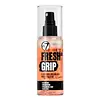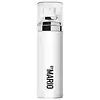What's inside
What's inside
 Key Ingredients
Key Ingredients

 Benefits
Benefits

 Concerns
Concerns

 Ingredients Side-by-side
Ingredients Side-by-side

Water
Skin ConditioningIsononyl Isononanoate
EmollientAloe Barbadensis Leaf Juice
Skin ConditioningCaprylic/Capric Triglyceride
MaskingSqualane
EmollientPhenoxyethanol
PreservativeCamellia Japonica Seed Oil
EmollientSimmondsia Chinensis Seed Oil
EmollientHelianthus Annuus Seed Oil
EmollientTocopheryl Acetate
AntioxidantPotassium Sorbate
PreservativeSodium Benzoate
MaskingPvp
Emulsion StabilisingHydroxyacetophenone
AntioxidantAllantoin
Skin ConditioningHydroxyethyl Urea
HumectantSodium Chloride
MaskingGlycerin
HumectantTetrasodium Glutamate Diacetate
Arginine
MaskingEthylhexylglycerin
Skin ConditioningCitric Acid
BufferingPentylene Glycol
Skin ConditioningSodium Hyaluronate
HumectantSodium Acetylated Hyaluronate
HumectantHyaluronic Acid
HumectantHydrolyzed Sodium Hyaluronate
Skin ConditioningCI 16035
Cosmetic ColorantCI 19140
Cosmetic ColorantWater, Isononyl Isononanoate, Aloe Barbadensis Leaf Juice, Caprylic/Capric Triglyceride, Squalane, Phenoxyethanol, Camellia Japonica Seed Oil, Simmondsia Chinensis Seed Oil, Helianthus Annuus Seed Oil, Tocopheryl Acetate, Potassium Sorbate, Sodium Benzoate, Pvp, Hydroxyacetophenone, Allantoin, Hydroxyethyl Urea, Sodium Chloride, Glycerin, Tetrasodium Glutamate Diacetate, Arginine, Ethylhexylglycerin, Citric Acid, Pentylene Glycol, Sodium Hyaluronate, Sodium Acetylated Hyaluronate, Hyaluronic Acid, Hydrolyzed Sodium Hyaluronate, CI 16035, CI 19140
Water
Skin ConditioningPvp
Emulsion StabilisingPhenoxyethanol
Preservative1,2-Hexanediol
Skin ConditioningNiacinamide
SmoothingButylene Glycol
Humectant3-O-Ethyl Ascorbic Acid
Skin ConditioningSodium Citrate
BufferingEthylhexylglycerin
Skin ConditioningCitric Acid
BufferingCaffeine
Skin ConditioningGlycerin
HumectantHyaluronic Acid
HumectantSodium Lauroyl Lactylate
EmulsifyingHydroxypropyltrimonium Hyaluronate
Hippophae Rhamnoides Extract
MaskingCeramide NP
Skin ConditioningCeramide AP
Skin ConditioningPhytosphingosine
Skin ConditioningAlteromonas Ferment Extract
Skin ConditioningCholesterol
EmollientXanthan Gum
EmulsifyingCarbomer
Emulsion StabilisingVaccinium Corymbosum Fruit Extract
Skin ConditioningEuterpe Oleracea Fruit Extract
Ceramide EOP
Skin ConditioningWater, Pvp, Phenoxyethanol, 1,2-Hexanediol, Niacinamide, Butylene Glycol, 3-O-Ethyl Ascorbic Acid, Sodium Citrate, Ethylhexylglycerin, Citric Acid, Caffeine, Glycerin, Hyaluronic Acid, Sodium Lauroyl Lactylate, Hydroxypropyltrimonium Hyaluronate, Hippophae Rhamnoides Extract, Ceramide NP, Ceramide AP, Phytosphingosine, Alteromonas Ferment Extract, Cholesterol, Xanthan Gum, Carbomer, Vaccinium Corymbosum Fruit Extract, Euterpe Oleracea Fruit Extract, Ceramide EOP
Ingredients Explained
These ingredients are found in both products.
Ingredients higher up in an ingredient list are typically present in a larger amount.
Citric Acid is an alpha hydroxy acid (AHA) naturally found in citrus fruits like oranges, lemons, and limes.
Like other AHAs, citric acid can exfoliate skin by breaking down the bonds that hold dead skin cells together. This helps reveal smoother and brighter skin underneath.
However, this exfoliating effect only happens at high concentrations (20%) which can be hard to find in cosmetic products.
Due to this, citric acid is usually included in small amounts as a pH adjuster. This helps keep products slightly more acidic and compatible with skin's natural pH.
In skincare formulas, citric acid can:
While it can provide some skin benefits, research shows lactic acid and glycolic acid are generally more effective and less irritating exfoliants.
Most citric acid used in skincare today is made by fermenting sugars (usually from molasses). This synthetic version is identical to the natural citrus form but easier to stabilize and use in formulations.
Read more about some other popular AHA's here:
Learn more about Citric AcidEthylhexylglycerin (we can't pronounce this either) is commonly used as a preservative and skin softener. It is derived from glyceryl.
You might see Ethylhexylglycerin often paired with other preservatives such as phenoxyethanol. Ethylhexylglycerin has been found to increase the effectiveness of these other preservatives.
Glycerin is already naturally found in your skin. It helps moisturize and protect your skin.
A study from 2016 found glycerin to be more effective as a humectant than AHAs and hyaluronic acid.
As a humectant, it helps the skin stay hydrated by pulling moisture to your skin. The low molecular weight of glycerin allows it to pull moisture into the deeper layers of your skin.
Hydrated skin improves your skin barrier; Your skin barrier helps protect against irritants and bacteria.
Glycerin has also been found to have antimicrobial and antiviral properties. Due to these properties, glycerin is often used in wound and burn treatments.
In cosmetics, glycerin is usually derived from plants such as soybean or palm. However, it can also be sourced from animals, such as tallow or animal fat.
This ingredient is organic, colorless, odorless, and non-toxic.
Glycerin is the name for this ingredient in American English. British English uses Glycerol/Glycerine.
Learn more about GlycerinHyaluronic acid is naturally found in healthy skin. It is a humectant, meaning it draws moisture to your skin.
This ingredient helps hydrate, soothe, and protect the skin.
What makes hyaluronic acid so hydrating? It has the capacity to bind or hold large amounts of water.
Fun fact: It is already naturally found in our bodies, such as the fluids of our eyes and our joints.
Studies find this ingredient to have anti-inflammatory and anti-microbial properties. This can help speed up wound-healing.
Hyaluronic acid can be irritating if the molecule has a low-molecular weight, or if the molecules are small.
One study found low-molecular weight hyaluronic acid to be pro-inflammatory, meaning some people may experience irritation. This is because our bodies use hyaluronic acid in the wound-healing process to signal to our bodies, via irritation, that something needs healing.
The same study found high-molecular weight hyaluronic acid to be anti-inflammatory.
These are some other common types of Hyaluronic Acid:
Learn more about Hyaluronic AcidPhenoxyethanol is a preservative that has germicide, antimicrobial, and aromatic properties. Studies show that phenoxyethanol can prevent microbial growth. By itself, it has a scent that is similar to that of a rose.
It's often used in formulations along with Caprylyl Glycol to preserve the shelf life of products.
Pvp is a water-soluble synthetic polymer and common hairstyling ingredient. It is a film-forming ingredient and used to "hold" specific shapes of hair.
Pvp is less effective in high-humidity. It tends to draw moisture, but this moisture dismantles the structure and "hold".
Water. It's the most common cosmetic ingredient of all. You'll usually see it at the top of ingredient lists, meaning that it makes up the largest part of the product.
So why is it so popular? Water most often acts as a solvent - this means that it helps dissolve other ingredients into the formulation.
You'll also recognize water as that liquid we all need to stay alive. If you see this, drink a glass of water. Stay hydrated!
Learn more about Water